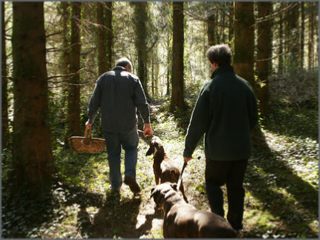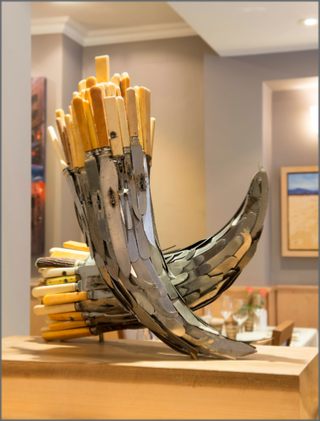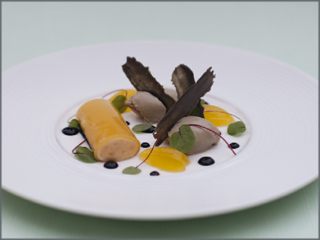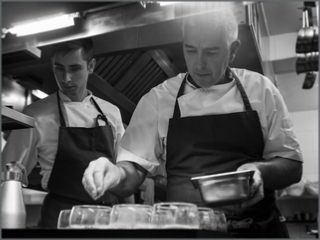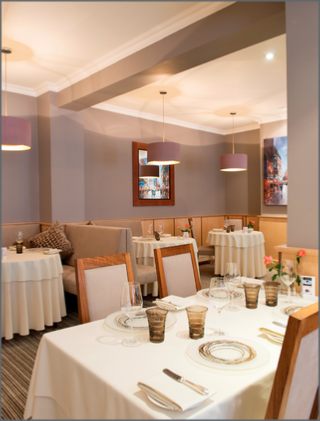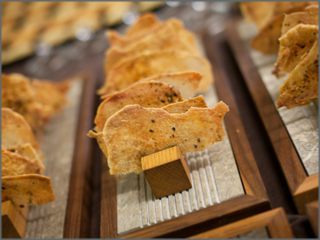

SUFFOLK ROAD CHELTENHAM
GLOS. GL50 2AQ
01242 573449
Wednesday - Saturday
12.30 - 1.15pm (last order: 1.30)
7.30 - 8.30pm (last order: 8.45)


reserve




food
menu
wine




info


maps


press


album



careers


earlier press coverage
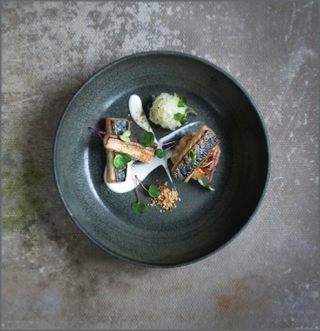
When King George III tried to get relief from his 'madness' -and perhaps derive consolation for losing America - by taking the salty, alkaline waters at Cheltenham Spa in 1788, he did more for the town than it did for him. After the royal visit, Cheltenham became Britain's most important spa while, unfortunately, the King remained as erratic as ever. These days you can still imbibe the stuff -but you'd still have to be crazy to spend several weeks swigging it as he did.
A better restorative would be a meal at Le Champignon Sauvage, a small restaurant that features some of the most expansively imaginative cooking in Britain. The sophisticated array of ingredients and flavours, beautifully resolved in each dish, none of which are quite like anything else anywhere, would set anyone right again. For us, choosing it as the Decanter/Charles Heidsieck Restaurant of the Year was as easy as picking up a fork.
On the residential edge of town, the cheery, brightly painted building stands out among a drab collection of antique shops and houses. It's a small, chef-and-wife-owned operation. David Everitt-Matthias is in the kitchen, while his wife Helen runs the front with genuine graciousness.She reassuringly describes dishes such as tortellini of eel with watercress cream sauce; pan-fried duck foie gras in a reduced sauce of Banyuls garnished with some astonishingly tender gizzards; lightly baked fillet of brill on pear and celeriac slices and toasted barley; and tender fillet of pork on a boudin noir that David smoothes by including sweetbreads in the mix, accompanied by stuffed cabbage and a complicated velvety sauce.
These dishes are typical of Everitt-Matthias's style: a pure marriage of rich and poor - offal, humble vegetables, ordinary seafood and charcuterie teamed with rich sauces, deluxe ingredients and surprising extra flavours. The restaurant opened 13 years ago, beginning with what he calls 'a fairly classic French orientation'. When the recession set in soon afterwards, he held his prices down by doing more with humble ingredients and by making as much as possible from scratch-butchering whole animals and using every bit, curing, pickling and drying fruit and vegetables himself, and even hunting for mushrooms.
'Some of that goes back to when I was seven,' he said. 'My aunt was sort of a hedgerow cook, and she used to take me out foraging with her. Then she'd cook up what we'd found - wild sorrel, crab apples, all sorts of mushrooms, cobnuts, that sort of thing. She taught me to have an open mind, to try things, and that got me interested in food. I decided then that I was going to be a cook.'
It's the only job he's ever had. He worked his way through catering college as an all-rounder in a London hotel kitchen, staying five years in order to take advanced courses at school, gaining invaluable practical experience. 'That dose of reality saved me from the shock some of my classmates got when they started work in a professional kitchen - it was a defInite advantage!'
From the start, Everitt-Matthias wanted his own restaurant, shopping all around the country for the right place. 'Helen and I had looked at a lot of places by the seaside - we had visions of ourselves lounging around a beach and having a swim between shifts. Aside from the fact that we were a little naive, there was the...
drawback that those places are seasonal, and we wanted to really build a business. This place, it seemed, was just right. Now we've got customers who trust us, who've grown up with us, so it worked.'
The wine list reflects the food and the reliance on a regular clientele. It's mostly French - more than 150 selections - and chosen and annotated by Helen. Most bottles are under £30, but there's also a good choice of classified burgundies and bordeaux, which are not stratospherically marked up. All in all, it's excellent value.
For years the Everitt-Matthiases were the only full-time employees, but with the ambitious evolution of his style and the steady expansion of business in the wake of two Michelin stars, there is now a brigade of two -Anthony Rush and Lisa Allan -plus a full-time waitress, Mary Barlow. Everything is still made from scratch. 'We're always making things ahead,' explains Everitt-Matthias. 'For all the ambition of the menu, there's a controlled logic to it, for ingredients as well as techniques. We pickle apples, quince and walnuts, for example, to pair with rich foods such as duck or foie gras, or to combine with seared scallops and Parma ham. We make soured cabbage, cured for a day in salt and then cooked in wine with bacon and spices, which we serve with rabbit or salmon. We also make real sauerkraut, kept in brine for three months, to serve with heavier meats like beef.'
Charcuterie is a major part of the mix, with everything from terrines to elaborate sausages making an appearance. 'I love doing it. Every year a few of us younger chefs go down to the Manor House in Romsey, where Pierre Koffman and Mauro Bregoli get in a couple of pigs and let us help and learn. Pierre does French, Mauro does Italian with no airs or graces, just passing on their knowledge.'
It's no surprise that many of his friends are also chefs: 'I get on the phone with Heston Blumenthal at the Fat Duck, or Martin Blunos at Lettonie, or Claude Bosi at Hibiscus in Ludlow. We all enjoy experimenting and talking, and we're not frightened to share - none of that "secret recipe" business for us.'
If there is a drawback to his set-up, it's that he can't get out and eat enough to see fIrst-hand what other chefs are up to in Bray or Ludlow, or Barcelona: 'I hear there's a young generation there doing great things. It's important to get out to listen to the way people talk about food, whether colleagues or customers. There are always simple things you've forgotten about, things that are worth remembering,' he explains.
'Times change, people's tastes change. Sometimes the best change is to make something simpler. A lot of the time, you see young chefs look at a plate, and you know they're thinking, "Well, at my place we've got 26 garnishes on a plate; our food's gotta be better than this," and you know they haven't yet worked out the effort that went into the sauce, or how the meat was hung just long enough, and how everything on the plate complements everything else, and how everything doesn't have to be complicated. It all goes back to balance. Simple as that.
'In the end, confidence comes from cooking what you're happy cooking. I started out cooking what I thought the customers might want, and it didn't always work. When I started cooking for me, I found my way.'
BRIAN ST PIERRE, DECANTER
